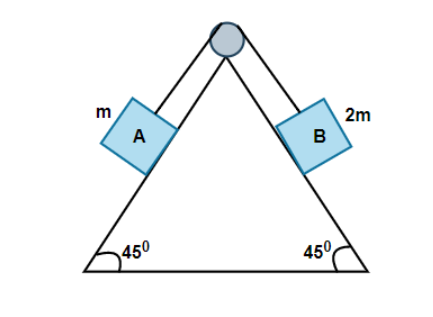
The velocity vector $v$ and displacement vector $x$of a particle executing SHM are related as \[V\dfrac{{dv}}{{dx}} = - {w^2}x\] with the initial condition \[v = {v_0}\]at \[x = 0\] the velocity \[{v_s}\] when displacement is$x$, is
(A) \[v = \sqrt {v{}_0^2 + {w^2}{x^2}} \]
(B) \[v = \sqrt {v{}_0^2 - {w^2}{x^2}} \]
(c) \[v = \sqrt {v{}_0^3 + {w^3} + {x^3}} \]
(D) \[v = {v_0} - {({w^3}{x^3}{e^x}^{^3})^{\dfrac{1}{3}}}\]

Answer
135.6k+ views
Hint In mechanics and physics, simple harmonic motion is a special type of periodic motion where the restoring force on the moving object is directly proportional to the object's displacement magnitude and acts towards the object's equilibrium position. It is vibratory motion in a system in which the restoring force is proportional to the displacement from equilibrium
Step by step solution
As it is Simple harmonic motion so the equation of motion will be
\[F = - kx\]
Or the equation can be written as
\[\dfrac{{vdv}}{{dx}} = - {\omega ^2}x\]
Now integrating the expression with boundary condition,
\[\int\limits_{{v_0}}^v {vdv} = - {\omega ^2}\int\limits_0^x {xdx} \]
After integrating the above equation we get
$\left[ {\dfrac{{{v^2}}}{2}} \right]_{{v_0}}^v = - {\omega ^2}\left[ {\dfrac{{{x^2}}}{2}} \right]_0^x$
Now we have to apply the limit in the above equation so we get
$\left[ {\dfrac{{{v^2}}}{2} - \dfrac{{v_0^2}}{2}} \right] = - {\omega ^2}\left[ {\dfrac{{{x^2}}}{2}} \right]$
Now we have to do further calculation then we get
$\dfrac{1}{2}\left[ {{v^2} - v_0^2} \right] = \dfrac{{ - {\omega ^2}{x^2}}}{2}$
Now after simplifying the above equation we get
$v = \sqrt {v{}_0^2 - {\omega ^2}{x^2}} $
Hence the correct answer is option is (B)
Note
A speed vector speaks to the pace of progress of the situation of an object.The greatness of a speed vector gives the speed of an article while the vector course gives its direction.Velocity vectors can be added or deducted by the standards of vector addition.In math and mechanics, a relocation is a vector whose length is the most limited good ways from the underlying to the last situation of a point P going through movement. It quantifies both the distance and direction of the net or total motion along a straight line from the initial position to the final position of the point trajectory. A displacement may be identified with the translation that maps the initial position to the final position.
Step by step solution
As it is Simple harmonic motion so the equation of motion will be
\[F = - kx\]
Or the equation can be written as
\[\dfrac{{vdv}}{{dx}} = - {\omega ^2}x\]
Now integrating the expression with boundary condition,
\[\int\limits_{{v_0}}^v {vdv} = - {\omega ^2}\int\limits_0^x {xdx} \]
After integrating the above equation we get
$\left[ {\dfrac{{{v^2}}}{2}} \right]_{{v_0}}^v = - {\omega ^2}\left[ {\dfrac{{{x^2}}}{2}} \right]_0^x$
Now we have to apply the limit in the above equation so we get
$\left[ {\dfrac{{{v^2}}}{2} - \dfrac{{v_0^2}}{2}} \right] = - {\omega ^2}\left[ {\dfrac{{{x^2}}}{2}} \right]$
Now we have to do further calculation then we get
$\dfrac{1}{2}\left[ {{v^2} - v_0^2} \right] = \dfrac{{ - {\omega ^2}{x^2}}}{2}$
Now after simplifying the above equation we get
$v = \sqrt {v{}_0^2 - {\omega ^2}{x^2}} $
Hence the correct answer is option is (B)
Note
A speed vector speaks to the pace of progress of the situation of an object.The greatness of a speed vector gives the speed of an article while the vector course gives its direction.Velocity vectors can be added or deducted by the standards of vector addition.In math and mechanics, a relocation is a vector whose length is the most limited good ways from the underlying to the last situation of a point P going through movement. It quantifies both the distance and direction of the net or total motion along a straight line from the initial position to the final position of the point trajectory. A displacement may be identified with the translation that maps the initial position to the final position.
Recently Updated Pages
JEE Main 2025 Session 2 Form Correction (Closed) – What Can Be Edited

What are examples of Chemical Properties class 10 chemistry JEE_Main

JEE Main 2025 Session 2 Schedule Released – Check Important Details Here!

JEE Main 2025 Session 2 Admit Card – Release Date & Direct Download Link

JEE Main 2025 Session 2 Registration (Closed) - Link, Last Date & Fees

JEE Mains Result 2025 NTA NIC – Check Your Score Now!

Trending doubts
JEE Main 2025 Session 2: Application Form (Out), Exam Dates (Released), Eligibility, & More

JEE Main 2025: Derivation of Equation of Trajectory in Physics

Degree of Dissociation and Its Formula With Solved Example for JEE

A body is falling from a height h After it has fallen class 11 physics JEE_Main

Electric Field Due to Uniformly Charged Ring for JEE Main 2025 - Formula and Derivation

Elastic Collisions in One Dimension - JEE Important Topic

Other Pages
JEE Advanced Marks vs Ranks 2025: Understanding Category-wise Qualifying Marks and Previous Year Cut-offs

Units and Measurements Class 11 Notes: CBSE Physics Chapter 1

Important Questions for CBSE Class 11 Physics Chapter 1 - Units and Measurement

NCERT Solutions for Class 11 Physics Chapter 2 Motion In A Straight Line

NCERT Solutions for Class 11 Physics Chapter 1 Units and Measurements

Motion In A Plane: Line Class 11 Notes: CBSE Physics Chapter 3




